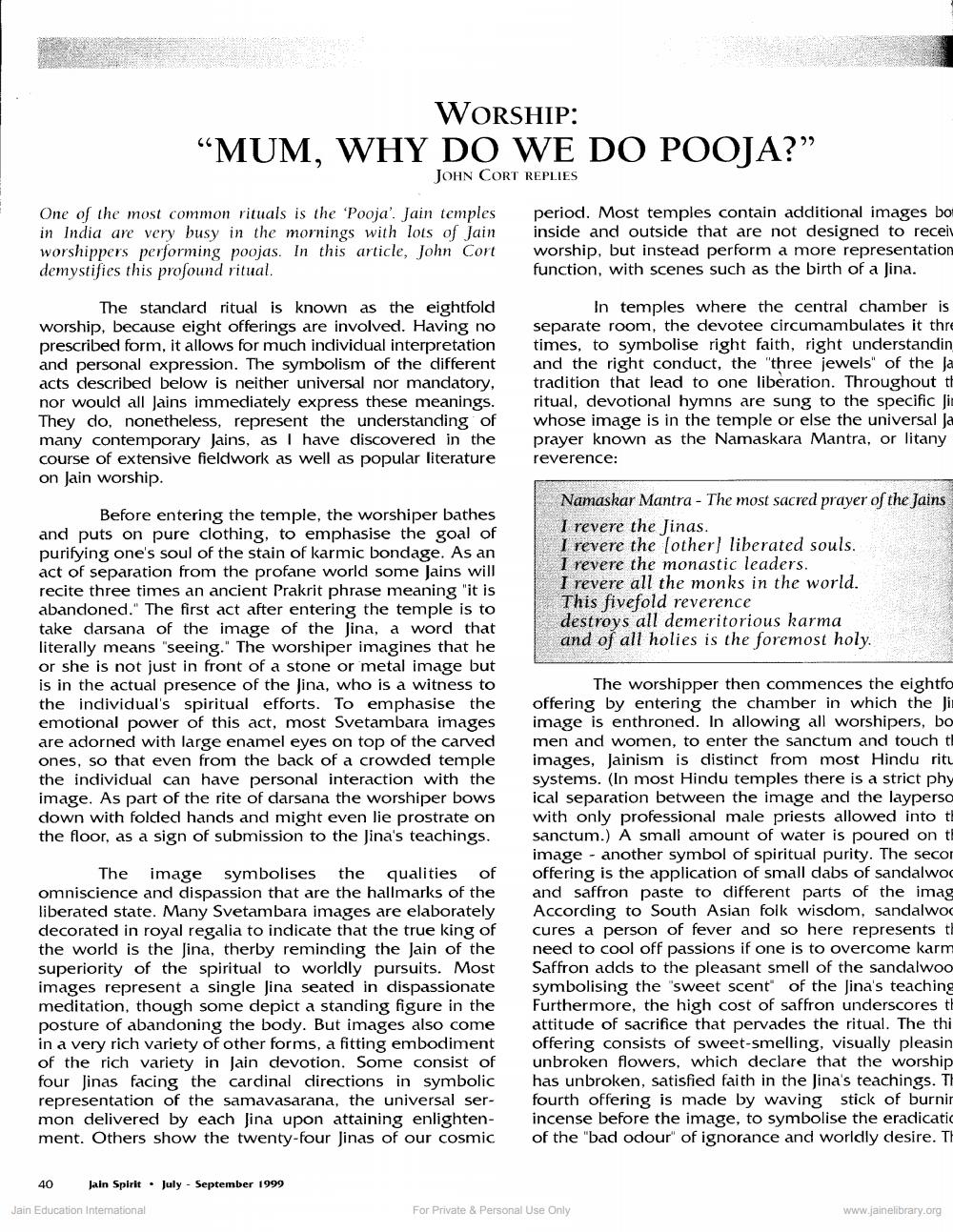________________
WORSHIP: “MUM, WHY DO WE DO POOJA?”
JOHN CORT REPLIES
One of the most common rituals is the 'Pooja' Jain temples in India are very busy in the mornings with lots of Jain worshippers performing poojas. In this article, John Cort demystifies this profound ritual.
period. Most temples contain additional images bot inside and outside that are not designed to receiv worship, but instead perform a more representation function, with scenes such as the birth of a Jina.
The standard ritual is known as the eightfold worship, because eight offerings are involved. Having no prescribed form, it allows for much individual interpretation and personal expression. The symbolism of the different acts described below is neither universal nor mandatory, nor would all Jains immediately express these meanings. They do, nonetheless, represent the understanding of many contemporary Jains, as I have discovered in the course of extensive fieldwork as well as popular literature on Jain worship.
In temples where the central chamber is separate room, the devotee circumambulates it thre times, to symbolise right faith, right understandin and the right conduct, the "three jewels" of the la tradition that lead to one liberation. Throughout th ritual, devotional hymns are sung to the specific Jin whose image is in the temple or else the universal la prayer known as the Namaskara Mantra, or litany reverence:
Namaskar Mantra - The most sacred prayer of the Jains I revere the Jinas. I revere the (other) liberated souls. I revere the monastic leaders. I revere all the monks in the world. This fivefold reverence destroys all demeritorious karma and of all holies is the foremost holy.
Before entering the temple, the worshiper bathes and puts on pure clothing, to emphasise the goal of purifying one's soul of the stain of karmic bondage. As an act of separation from the profane world some Jains will recite three times an ancient Prakrit phrase meaning "it is abandoned." The first act after entering the temple is to take darsana of the image of the Jina, a word that literally means "seeing." The worshiper imagines that he or she is not just in front of a stone or metal image but is in the actual presence of the Jina, who is a witness to the individual's spiritual efforts. To emphasise the emotional power of this act, most Svetambara images are adorned with large enamel eyes on top of the carved ones, so that even from the back of a crowded temple the individual can have personal interaction with the image. As part of the rite of darsana the worshiper bows down with folded hands and might even lie prostrate on the floor, as a sign of submission to the Jina's teachings.
The image symbolises the qualities of omniscience and dispassion that are the hallmarks of the liberated state. Many Svetambara images are elaborately decorated in royal regalia to indicate that the true king of the world is the fina, therby reminding the Jain of the superiority of the spiritual to worldly pursuits. Most images represent a single Jina seated in dispassionate meditation, though some depict a standing figure in the posture of abandoning the body. But images also come in a very rich variety of other forms, a fitting embodiment of the rich variety in Jain devotion. Some consist of four Jinas facing the cardinal directions in symbolic representation of the samavasarana, the universal sermon delivered by each fina upon attaining enlightenment. Others show the twenty-four Jinas of our cosmic
The worshipper then commences the eightfo offering by entering the chamber in which the Jin image is enthroned. In allowing all worshipers, bo men and women, to enter the sanctum and touch th images, Jainism is distinct from most Hindu ritu systems. (In most Hindu temples there is a strict phy ical separation between the image and the layperso with only professional male priests allowed into ti sanctum.) A small amount of water is poured on ti image - another symbol of spiritual purity. The seco offering is the application of small dabs of sandalwoc and saffron paste to different parts of the imag According to South Asian folk wisdom, sandalwoo cures a person of fever and so here represents to need to cool off passions if one is to overcome karm Saffron adds to the pleasant smell of the sandalwoo symbolising the "sweet scent" of the Jina's teaching Furthermore, the high cost of saffron underscores th attitude of sacrifice that pervades the ritual. The thi offering consists of sweet-smelling, visually pleasin unbroken flowers, which declare that the worship has unbroken, satisfied faith in the Jina's teachings. TH fourth offering is made by waving stick of burnir incense before the image, to symbolise the eradicatic of the "bad odour" of ignorance and worldly desire. Th
40
Jain Spirit. July - September 1999
Jain Education Intemational
For Private & Personal Use Only
www.jainelibrary.org




